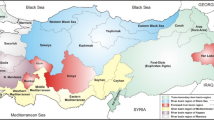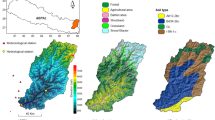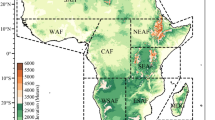Abstract
The growing need for local climate change scenarios has given rise to a wide range of empirical climate downscaling techniques. One of the most critical decisions in these methodologies is the selection of appropriate predictor variables for the downscaled surface predictand. A systematic approach to selecting predictor variables should be employed to ensure that the most important variables are utilized for the study site where the climate change scenarios are being developed. Tropical study areas have been far less examined than mid- and high-latitudes in the climate downscaling literature. As a result, studies analyzing optimal predictor variables for tropics are limited. The objectives of this study include developing artificial neural networks for six sites around Puerto Rico to develop nonlinear functions between 37 atmospheric predictor variables and local rainfall. The relative importance of each predictor is analyzed to determine the most important inputs in the network. Randomized ANNs are produced to determine the statistical significance of the relative importance of each predictor variable. Lower tropospheric moisture and winds are shown to be the most important variables at all sites. Results show inter-site variability in u- and v-wind importance depending on the unique geographic situation of the site. Lower tropospheric moisture and winds are physically linked to variability in sea surface temperatures (SSTs) and the strength and position of the North Atlantic High Pressure cell (NAHP). The changes forced by anthropogenic climate change in regional SSTs and the NAHP will impact rainfall variability in Puerto Rico.





Similar content being viewed by others
References
Bellerby T, Todd M, Kniveton D, Kidd C (2000) Rainfall estimation from a combination of TRMM precipitation radar and GOES multispectral satellite imagery through the use of an artificial neural network. J Appl Meteorol 39:2115–2128
Cavazos T (1999) Large-scale circulation anomalies conducive to extreme precipitation events and derivation of daily rainfall in northeastern Mexico and southeastern Texas. J Clim 12:1506–1523. doi:10.1175/1520-0442(1999)012<1506:LSCACT>2.0.CO;2
Cavazos T, Hewitson BC (2005) Performance of NCEP-NCAR reanalysis variables in statistical downscaling of daily precipitation. Clim Res 28:95–107. doi:10.3354/cr028095
Comarazamy DE, González JE (2008) On the validation of the simulation of early season precipitation on the Island of Puerto Rico using a mesoscale atmospheric model. J Hydrometeorol 9:507–520. doi:10.1175/2007jhm804.1
Comarazamy DE, González JE (2011) Regional long-term climate change (1950–2000) in the midtropical Atlantic and its impacts on the hydrological cycle of Puerto Rico. J Geophys Res. doi:10.1029/2010jd015414
Crook K, Scatena FN, Pringle CM (2007) Water withdrawn from the Luquillo experimental forest, 2004. USDA forest service general technical report IITF-GTR-34
Daly C, Helmer EH, Quiñones M (2003) Mapping the climate of Puerto Rico, Vieques and Culebra. Int J Clim 23:1359–1381. doi:10.1002/joc.937
Dee D et al (2011) The ERA-Interim reanalysis: configuration and performance of the data assimilation system. Q J R Meteorolog Soc 137:553–597
Enfield DB, Alfaro EJ (1999) The dependence of Caribbean rainfall on the interaction of the tropical Atlantic and Pacific Oceans. J Clim 12:2093–2103. doi:10.1175/1520-0442(1999)012<2093:TDOCRO>2.0.CO;2
Gamble DW, Curtis S (2008) Caribbean recipitation: review, model and prospect. Prog Phys Geogr 32:265–276. doi:10.1177/0309133308096027
Gardner MW, Dorling SR (1998) Artificial neural networks (the multilayer perceptron)—a review of applications in the atmospheric sciences. Atmos Environ 32:2627–2636. doi:10.1016/S1352-2310(97)00447-0
Garson DG (1991) Interpreting neural-network connection weights. Artif Intell Expert 6:47–51
Giannini A, Kushnir Y, Cane MA (2000) Interannual variability of Caribbean rainfall, ENSO, and the Atlantic Ocean. J Clim 13:297–311. doi:10.1175/1520-0442(2000)013<0297:IVOCRE>2.0.CO;2
Giorgi F et al (2001) Emerging patterns of simulated regional climatic changes for the 21st century due to anthropogenic forcings. Geophys Res Lett 28:3317–3320
Goh A (1995) Back-propagation neural networks for modeling complex systems. Artif Intell Eng 9:143–151
Granger OE (1985) Caribbean climates. Prog Phys Geogr 9:16–43
Gutnick M (1958) Climatology of the trade-wind inversion in the Caribbean. Bull Am Meteorol Soc 39:410–420
Hall T, Brooks HE, Doswell CA III (1999) Precipitation forecasting using a neural network. Weather Forecast 14:338–345
Hastenrath S (1976) Variations in low-latitude circulation and extreme climatic events in the tropical Americas. J Atmos Sci 33:202–215
Haylock MR, Cawley GC, Harpham C, Wilby RL, Goodess CM (2006) Downscaling heavy precipitation over the United Kingdom: a comparison of dynamical and statistical methods and their future scenarios. Int J Clim 26:1397–1415. doi:10.1002/joc.1318
Hewitson BC, Crane RG (1992) Large-Scale atmospheric controls on local precipitation in tropical Mexico. Geophys Res Lett 19:1835–1838
Hewitson BC, Crane RG (1994) Neural nets: applications in geography: applications for geography, vol 29. Springer, Berlin
Hewitson B, Crane R (1996) Climate downscaling: techniques and application. Clim Res 7:85–95
Jury MR (2009) An intercomparison of observational, reanalysis, satellite, and coupled model data on mean rainfall in the Caribbean. J Hydrometeorol 10:413–430
Kuligowski RJ, Barros AP (1998) Localized precipitation forecasts from a numerical weather prediction model using artificial neural networks. Weather Forecast 13:1194–1204. doi:10.1175/1520-0434(1998)013<1194:LPFFAN>2.0.CO;2
Larsen MC (2000) Analysis of 20th century rainfall and streamflow to characterize drought and water resources in Puerto Rico. Phys Geogr 21:494–521
Maier HR, Dandy GC (2000) Neural networks for the prediction and forecasting of water resources variables: a review of modelling issues and applications. Environ Modell Softw 15:101–124
Malmgren BA, Winter A (1999) Climate zonation in puerto rico based on principal components analysis and an artificial neural network. J Clim 12:977–985. doi:10.1175/1520-0442(1999)012<0977:CZIPRB>2.0.CO;2
Marzban C (2009) Performance measures and uncertainty. In: Haupt S, Pasini A, Marzban C (eds) Artificial intelligence methods in the environmental sciences. Springer, Netherlands, pp 49–75. doi:10.1007/978-1-4020-9119-3_3
Menne MJ, Durre I, Vose RS, Gleason BE, Houston TG (2012) An overview of the global historical climatology network-daily database. J Atmos Ocean Technol 29:897–910
Nobre P, Srukla J (1996) Variations of sea surface temperature, wind stress, and rainfall over the tropical Atlantic and South America. J Clim 9:2464–2479
Olden JD, Jackson DA (2002) Illuminating the “black box”: a randomization approach for understanding variable contributions in artificial neural networks. Ecol Model 154:135–150. doi:10.1016/S0304-3800(02)00064-9
Sahai A, Soman M, Satyan V (2000) All India summer monsoon rainfall prediction using an artificial neural network. Clim Dyn 16:291–302
Schoof JT, Pryor SC (2001) Downscaling temperature and precipitation: a comparison of regression-based methods and artificial neural networks. Int J Clim 21:773–790. doi:10.1002/joc.655
Schubert WH, Ciesielski PE, Lu C, Johnson RH (1995) Dynamical adjustment of the trade wind inversion layer. J Atmos Sci 52:2941–2952
Silverman D, Dracup JA (2000) Artificial neural networks and long-range precipitation prediction in California. J Appl Meteorol 39:57–66. doi:10.1175/1520-0450(2000)039<0057:ANNALR>2.0.CO;2
Taylor MA, Enfield DB, Chen AA (2002) Influence of the tropical Atlantic versus the tropical Pacific on Caribbean rainfall. J Geophys Res: Ocean 107:10-11-10-14
Trenberth KE, Dai A, Rasmussen RM, Parsons DB (2003) The changing character of precipitation. Bull Am Meteorol Soc 84:1205–1217
Tsonis AA, Elsner JB (1992) Nonlinear Prediction as a way of distinguishing chaos from random fractal sequences. Nature 358:217–220
Valverde Ramírez MC, de Campos Velho HF, Ferreira NJ (2005) Artificial neural network technique for rainfall forecasting applied to the São Paulo region. J Hydrol 301:146–162. doi:10.1016/j.jhydrol.2004.06.028
Wilby R, Charles S, Zorita E, Timbal B, Whetton P, Mearns L (2004) Guidelines for use of climate scenarios developed from statistical downscaling methods. Supporting material of the intergovernmental panel on climate change, DDC of IPCC TGCIA
Winkler JA et al (2011) Climate scenario development and applications for local/regional climate change impact assessments: an overview for the non-climate scientist. Geogr Compass 5:275–300. doi:10.1111/j.1749-8198.2011.00425.x
Wu R, Kirtman BP (2005) Roles of Indian and Pacific Ocean air–sea coupling in tropical atmospheric variability. Clim Dyn 25:155–170
Wu R, Kirtman BP (2011) Caribbean Sea rainfall variability during the rainy season and relationship to the equatorial Pacific and tropical Atlantic SST. Clim Dyn 37:1533–1550
Author information
Authors and Affiliations
Corresponding author
Rights and permissions
About this article
Cite this article
Ramseyer, C.A., Mote, T.L. Atmospheric controls on Puerto Rico precipitation using artificial neural networks. Clim Dyn 47, 2515–2526 (2016). https://doi.org/10.1007/s00382-016-2980-3
Received:
Accepted:
Published:
Issue Date:
DOI: https://doi.org/10.1007/s00382-016-2980-3




